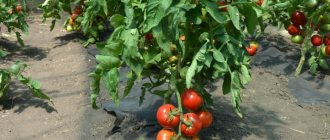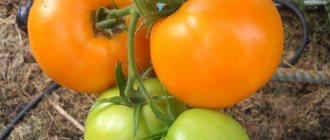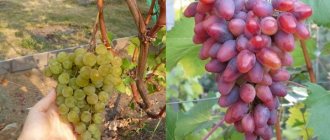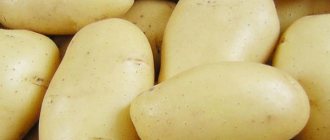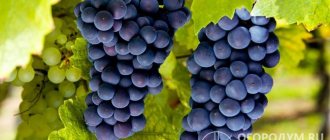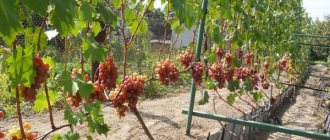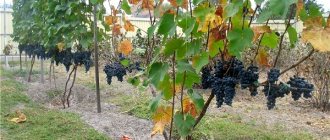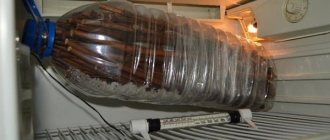The author's collection of grape plants, created by the famous amateur breeder Viktor Nikolaevich Krainov, includes a considerable number of worthy hybrid forms and species. These include the table grape variety “Anyuta”, which is well “rooted” throughout our country, as well as in Ukraine and Belarus.
The berries of the Anyuta grape variety (pictured) attract attention with a color scheme reminiscent of red-sided cherries - from yellow-cream to deep pink
The numerous advantages of this relatively “young” variety of crop are of interest to production workers and summer residents. In the article we will talk about the features of “almost ideal” grapes, and we will start with its main characteristics:
| Parameter | Characteristic |
| Culture | Grapes (Vitis Vinifera L.) |
| Variety | "Anyuta" |
| Direction of use | Dining room |
| Flower type | Bisexual |
| Bush growth vigor | Big |
| Ripening time | Mid-early: late August – early September (130-140 days from the start of the growing season) |
| Consumption period (fruit shelf life) | Summer (autumn); in the refrigerator for about 4 months |
| Precociousness | For the 4th year |
| Productivity of one bush per season | High: about 7-10 kg (maximum – 20-30 kg); in industrial plantings – 21.0 t/ha |
| Bunch shape and weight | Large, conical or wide-conical, sometimes loose or medium-dense; weighing on average 500-710 g, maximum – up to 1.1-1.5 kg |
| Shape and color of berries | Very large, uniform, oval; the skin is dense, of medium thickness; color from pink-red to crimson |
| Mass of berries | 10-17 g |
| Pulp | Meaty, juicy, less often dense, crispy |
| Purpose of fruits | Dessert type |
| Tasting assessment | 8.3-9.0 (out of 10) – harmonious taste with a pronounced nutmeg flavor and a hint of honey in the aftertaste |
| Disease resistance | Increased to gray rot and oidium – 2.5 points (out of 5); to mildew 3.5-4 points (out of 5); susceptible to phylloxera |
| Winter hardiness | Withstands frosts down to −21… −22 ℃ (in most regions requires shelter for the winter) |
| Year of registration in the State Register of the Russian Federation | 2016 |
| Recommended growing regions | All regions |
| Originator/patent holder | Federal State Budgetary Institution "Federal Rostov Agrarian Research Center" (Rostov region) |
Advantages and disadvantages
Pros:
- High yield.
- Large fruit.
- Excellent taste characteristics.
- Fleshy and dense pulp.
- Resistance to fungal diseases.
- Transportability.
- Keeping quality.
- Easy to care for.
- No peas.
- High rates of survival of cuttings.
Minuses:
- Need for shelter for the winter.
- Presence of seeds.
- Late ripening.
- Uneven ripening of fruits in the cluster.
- Intolerance to large amounts of precipitation and high humidity.
- The need for rationing.
- Short period of stay on the vine without loss of consumer qualities.
History of selection
The “Ayuta” variety is a crossing of the Rosanna and Cardinal resistant varieties (Rosanna*K-81). The author of the variety, E.G. Pavlovsky, has been successfully selecting varieties for thirty years.
The Kinglet, the Count of Monte Cristo and the Monarch also belong to his hand.
This variety can grow in different zones of Russia . But Ayuta takes root especially well in the Black Earth Region.
Due to its high sugar accumulation, it can be grown in cooler regions. The climatic conditions of the region do not affect the taste.
Reference. E.G. Pavlovsky is the author of more than fifty types of hybrid forms. During his career, he mastered all existing green grafting techniques for growing large bushes and for small grafted seedlings. At the moment, Evgeniy Georgievich Pavlovsky is developing new promising forms. He grows more than two thousand varieties to order.
His works are known not only in Russia and the CIS countries, but also abroad.
Origin
“Anyuta” is a “sister” of the “Victor” variety, obtained as a result of crossing the same parent pair - “Kishmish radiata” and “Talisman”. This variety was created about 10 years ago by a Russian amateur breeder from the Rostov region, Viktor Nikolaevich Krainov, who named it in honor of his granddaughter. The variety was included in the State Register in 2021. Parents of “Anyuta” – “Kishmish Radiant” and “Talisman”
Main characteristics
“Anyuta” is an unpretentious variety with a medium-late ripening period, which annually produces a consistently high yield.
Ripening period
The growing season of “anyuta” lasts around 135-150 days. In regions with a mild climate, the period for harvesting berries occurs in the first days of September, in the northern regions - at the beginning of October. The bushes begin to bear fruit at 4-5 years of age.
Bush
The variety is distinguished by a powerful and durable vine with a tendency to thicken as it develops. It grows up to 2-3 meters and matures at 80% of its length. The bark of young shoots is light brown, but after they bear fruit, it changes color to reddish-brown.
The leaves are large, light green with pointed teeth along the edges. They can be divided into 3 or 5 parts. The back surface of the leaf blade has no edge.
The flowers are bisexual, so the bushes can be used as pollinators for other varieties of grapes. The root system is highly developed, so plants need a large nutrient area. It is necessary to cover the roots for the winter - they are very sensitive to frost.
The seedlings take root well and quickly adapt to new conditions. The vines have a high growth rate and require pruning and rationing.
bunches
“Anyuta” brushes are formed in the shape of a cone and are distinguished by branching. They are quite large, the average weight varies between 0.7-1 kg. However, with strict adherence to the rules of agricultural technology, you can get bunches weighing up to 2.5 kg.
The berries are arranged loosely in them - the brushes are loose in structure, which makes them convenient for consumption. The bunches should be cut as they ripen - otherwise, the fruits will lose their visual appeal and taste.
Berries and taste
The ellipsoidal berries of “pansy” resemble the shape of a large olive, slightly pointed towards the tip. Their parameters:
- Length - 40-60 mm.
- Width - 25-30 mm.
- Weight - up to 20 g.
The fruits have a delicate nutmeg taste and a pleasant honey aroma. Its harmony is given by the balance between sugar content - 18-20% and acidity - 6-8%.
The color of the berries depends on the region and growing conditions and varies from pale pink to reddish-crimson. The pulp is dense, tender, fleshy and contains a large amount of juice.
Pansy berry in cross section
Berries can have 3-4 full seeds or 1-2 rudiments. This depends on the pollination conditions of the bushes - the higher the ambient temperature, the greater the likelihood of seed formation.
The skin is thin, so it is practically not felt during consumption. It tends to crack with excessive watering, heavy rain - in conditions of high humidity.
Productivity
Winegrowers classify “anyuta” as a high-yielding variety: about 6-10 kg of berries can be harvested from one bush, on an industrial scale - 190 c/ha.
Reference! Productivity is stable and remains at the proper level every year, provided that excess ovaries are removed in a timely manner - the bushes react poorly to overloading of the vines.
Rules for planting grapes
Recommended timing
To cultivate Anyuta grapes on your site, you need to familiarize yourself with certain rules. First of all, you should choose the timing of planting. Typically, grape crops are planted in autumn or spring.
The most suitable time is spring, as the warmth will help the plant grow stronger and adapt to the coming frosts.
Choosing a suitable location
When choosing a planting site, you need to make sure that the soil for planting is fertile. Chernozem or loamy soil is most suitable for grape crops.
Another condition for cultivating Anyuta is sunlight. The place for the bushes should be well lit and protected from drafts. There should be a minimum of 80 cm between plant recesses.
Selection and preparation of planting material
It is necessary to prepare material for planting in February. The cuttings should be placed in damp pine sawdust. After approximately 20 days, when the first roots appear, the planting material should be transferred to a container with a mixture of peat, sand and compost (1:1:1). The container must be placed on the windowsill.
Landing algorithm
Grapes should be planted in open soil at the end of spring, when the seedling or cuttings have developed. Before this, the soil must be dug up and fertilized.
Stages of planting Anyuta grapes:
- Dig a hole approximately 0.8 m in diameter.
- Fill the bottom of the depression with pebbles or crushed stone.
- Run a pipe to it to supply moisture to the root system.
- Place the plant in the hole. There is no need to place the seedlings too deep; 2-3 buds should be located above the surface of the soil.
- Cover the seedling or cutting with soil.
- Water the soil generously and mulch it.
Features of cultivation
To get a good harvest of “pansy” you need not only to choose the right place to plant the bushes, but also to ensure that the fruits ripen in suitable conditions. Fortunately, you don’t have to worry about the appearance of diseases - the variety is resistant to gray rot, oidium and mildew.
Planting and soil
It is allowed to plant pansy bushes both in spring and autumn. The first option is preferable, since in the warmth it is easier for plants to adapt to environmental conditions and prepare for the first wintering. This is especially true for regions with short and cold autumns.
Work can begin when the risk of frost becomes minimal and the soil warms up to 7-10ºC. After the procedure, it is recommended to spray the bush with iron sulfate: this will delay the growing season, and the development of the root system will be more active.
Autumn planting is usually carried out in October - 3 weeks before the onset of the first stable frost. When choosing this option, seedlings must be covered.
It is better to choose a place for a vineyard on the south side - this way the vine will form more lush and give an excellent harvest. In addition, with enough sunlight, fruits will ripen more evenly.
The grapes feel good near buildings and structures: they have additional support and protection from drafts and cold winds. This is especially true when growing “pansy” in central Russia.
Recommendations for planting:
- The planting pit must have dimensions of at least 70x70x70 cm.
- A distance of about 1 m should be maintained between bushes.
- If grapes are planted along the wall of a building, it is necessary to retreat 0.7-1.5 m from it.
- The pit should be prepared in advance - 2-3 weeks before the expected date of the procedure.
- At the bottom of the hole it is necessary to lay out 10-15 cm of drainage. You can use crushed brick, crushed stone or tiles for it.
- It is necessary to add humus and phosphorus-potassium fertilizer to the pit.
- The seedlings should not be deeply buried - 2-3 buds should remain above the soil surface.
- You should immediately take care of support for the bushes.
- After planting the plant, it is important to water thoroughly and mulch the area around the shoots.
The variety does not have any special requirements for soil composition; the main thing is not to plant it on substrates with a significant salt content and a high level of groundwater. “Anyuta” bears fruit best on loose, neutral or slightly alkaline soil. Therefore, it is recommended to “dilute” acidic soil with lime at the rate of 1 liter per 1 m2, and transform dense soil into permeable soil by adding perlite, peat and sand.
Care
The variety responds well to moderate watering. The procedure must be carried out:
- In the spring after removing the cover.
- Before and after flowering.
- During a drought.
Water the pansy at the rate of 5 buckets of water per bush. However, it should be remembered that excess moisture can cause more harm to grapes than drought. It is unacceptable to water the vines during flowering and the formation of berries - this can cause the buds to fall off and cracks to appear on the fruits.
Watering should be done very carefully - the green parts of the plant react negatively to contact with water. Therefore, it is better to carry out the procedure through drainage pipes or holes.
The pipe delivers water directly to the horse system. To install it you need:
- Dig a hole 70x70x70 cm 50-70 cm from the bush.
- Pour crushed stone into the bottom in a layer of about 30 cm.
- Insert a plastic or metal pipe with a diameter of 4-15 cm into it.
- Bury it so that it protrudes 15-20 cm above the surface.
Watering through holes is a simpler and more common method. To implement it, you need to dig several holes 25-30 cm deep around the perimeter of the bush and pour water through them. After the procedure, the recesses should be covered with earth.
The variety also needs fertilizing with mineral and organic fertilizers: nitrogen-containing substances are added in spring, and compounds rich in phosphorus and potassium are used in summer and autumn. They should be introduced simultaneously with watering.
Despite the high resistance of “anyuta” to diseases, prevention should not be neglected. Spraying should be carried out:
- Immediately after removing the cover, use a solution of copper sulfate.
- After the appearance of the 4th leaf - with some insecticide, for example, “Nitrophen”.
- Before the first flowers appear, use a complex fungicide (“Acrobat” or “Polychom”).
- Every 20 days in July-August - with a fungicide such as Quadrisa or Flint Star.
Reference! It is important to strictly follow the dosage indicated in the instructions.
Trimming
Pruning should be done in the fall immediately after the end of the growing season. It allows you to evenly distribute the load on the plant and improve the quality of the harvest. It is preferable to form a “anyuta” like a fan. No more than 30-35 eyes and 20-24 shoots should be left on the bush:
- Shorten fruiting vines by 8-12 buds.
- Remove damaged, thin, dry and immature (green) shoots.
Additionally, the variety needs to ration the number of berries. Therefore, you should leave 1 cluster on young shoots, and 2-3 on adults.
Frost resistance
“Anyuta” is distinguished by a high level of adaptability to moderate climatic conditions, but the same cannot be said about frost resistance. Bushes of this variety can withstand temperatures not lower than -22ºС and require shelter for the winter.
Immediately after pruning, the plants must be treated against diseases and pests and removed from the support. Then the vines should be laid on a bed of boards or slate and covered with burlap or any non-woven material on top. To increase thermal insulation, it is recommended to additionally cover the structure with spruce branches, and when snow falls, to form a snowdrift over it.
With the onset of spring, the shelter can be removed as soon as warm weather sets in.
If frost is likely in the growing region before the buds open, then it is better to leave the vines under protection, but make several holes in the material to ensure air circulation.
Storage
Pansy brushes are stored well - about 4 months after being removed from the bushes.
The main thing is not to leave them hanging on the vine for a long time, otherwise there is a risk that the fruits will become watery and lose their taste.
Possible difficulties
The most serious problem of the variety is considered to be bees and wasps - insects easily bite through the thin skin of the berries. Therefore, it is recommended to use traps against them, as well as pull nets or place brushes in bags as soon as the fruits begin to turn pink.
Berries are also susceptible to sunburn. With prolonged exposure to rays they do not stain and remain yellowish. Because of this, it is best not to remove leaves above the clusters.
Regions
Due to the fact that the variety adapts well to any climatic conditions, quickly takes root and develops, it can be grown not only in the southern but also in the central part of Russia.
Caring for Anyuta grape bushes
To obtain a commercial harvest, you must carefully care for the grape bushes.
- Cultivation is carried out on a trellis or similar strong support. It is advisable to position it so that the entire bush is illuminated by sunlight in the summer - this is extremely important!
- Watering is carried out as needed. The soil under the bushes should always be moist - drying out is unacceptable! During one watering, 3-5 buckets of water are poured under the bush. During flowering and ripening of berries, watering is reduced to a minimum.
- The soil under the bushes should be soft, so it is loosened from time to time with a hoe or rake. In the fall, you can even dig up the root zone and soil between the rows, but carefully, superficially, so as not to touch the roots of the grapes.
- The area where the grapes grow is kept completely clean. All emerging weeds must be removed immediately so that they do not spread diseases and pests.
Photo of spring pruning of Anyuta grapes
- Feeding is carried out several times during the season. This is very important, otherwise the bushes will quickly weaken and will not be able to fully bear fruit. In the spring, you can apply NPK mineral complexes under the bushes so that they quickly awaken after winter and begin to grow. In summer and autumn, phosphorus-potassium fertilizers or compost and humus are applied.
- Pruning of sleeves and all young shoots is carried out in early autumn, after harvesting. The bush has a significant growth force, so pruning must be thorough - each peg is shortened by 8 eyes.
- Experienced winegrowers never forget about rationing the harvest of the Anyuta variety. Of course, you don’t have to do this, but in this case the ripening will be incredibly slow. If you leave 2-3 of the largest bunches on each pagon, they will quickly ripen and delight you with taste.
It is recommended to cover the bushes for the winter even in the south; in any case, it is worth covering their ground part with agrofibre or similar material, and mulching the root zone with peat. Peat is laid in a layer of up to 25 cm. Instead, you can use moss, humus or blackened sawdust.
In the middle zone, bushes are completely removed from the trellis for the winter and laid on the ground. Then they need to be sprinkled with spruce branches, straw or something similar, and covered with burlap and agrofibre on top. If the winters are very cold, agrofibre is spread over the spruce branches, and the bushes should be sprinkled with earth on top of it.
Comparison with analogues
The table shows varieties similar to “Anyuta” and their characteristics.
| Sign | Variety | ||
| Anyuta | Amethyst | Victor | |
| Ripening period | 135-150 days | 100-110 days | 100-110 days |
| Frost resistance | up to -22°C | up to -29°C | up to -24°C |
| Yield per bush | 6-10 kg | 6-10 kg | 6-7 kg |
| Bunches | up to 2.5 kg | up to 0.9 kg | up to 2 kg |
| Taste | nutmeg floral honey | nutmeg | sweet with a little sourness |
| Color | pinkish to reddish-crimson | lilac to dark purple | from soft pink to purple |
| Disease resistance | high | average | high |
| Shelf life | up to 4 months | up to 3 months | up to 4 months |
Preventive spraying
The grapevine is treated with iron and copper sulfate or new preparations.
Important! Treatment with iron sulfate is contraindicated for bushes with leaves. They will get burned.
The Anyuta grape variety has high resistance to the most common diseases of cultivated vines - mildew and oidium. But for prevention, the bush must be sprayed with fungicides, which are offered in a wide range by the retail chain. All substances should be used strictly in accordance with the attached instructions.
It is advisable for everyone to have promising selective grape varieties on their plot.
Beneficial features
Grape fruits contain a large amount of nutrients and vitamins.
Berries contain:
- Chemical elements - calcium, manganese, cobalt, phosphorus, potassium, molybdenum, nickel, aluminum, iron, boron, chromium, ruby, zinc and copper.
- Vitamins - B1, B3, B5, B6 and B9, as well as C, P, E and carotenoids K and H;
- Flavonoids and bioflavonoids.
- Organic acids - citric, tartaric and malic;
- Pectin compounds.
At the same time, the sugar contained in fruits in the form of glucose and fructose is harmless and does not require insulin.
Due to its rich composition, grapes are used for the prevention and treatment of:
- Pathologies of the cardiovascular system.
- Diseases of the digestive and respiratory organs.
- Disturbances in the nervous, endocrine and reproductive systems.
- Alzheimer's diseases.
- Cancer diseases.
In addition, it is widely used by cosmetologists. Doctors also recommend consuming berries in case of loss of strength, general exhaustion of the body and regular mental activity. They also help fight vision impairment and extra pounds.
The leaves of the plant are also widely used in medicine and cooking, and they can even be consumed raw. In their fresh form they are used to improve blood circulation, in tea form to relieve cramps during painful menstruation, and in powder to treat wounds and cosmetic masks.
Grape seeds are a source of vitamin E, potassium and calcium. They perfectly remove toxins from the body, increase immunity, restore sexual function, and slow down the aging of the body. Seed oil is widely used in medicine, cosmetology and cooking.
Photo
Below are photos and reviews about the “Anyuta” variety.
Reviews
My impression of Anyuta is above average! The color and taste of the berry are like Radiant, only the berry is huge and a little harder. Ivan, Saratov
Anyuta is amazingly delicious and has no analogues! Excellent variety! Yuri Nikolaevich, Dnepr
Excellent presentation and taste. There is a little pea in the bunches, but this does not spoil their elegant appearance. Vitaly, Yalta, Crimea
Anyuta has great growth vigor, with an average ripening period of approximately the 10th of September. The bunches were from 1.2 kg or more. The berries are very large. The taste has a light nutmeg aroma. Roman, Nikopol
Video
If you are interested in the topic of the article, we also suggest watching videos made by experienced gardeners:
About the author:
Found a mistake? Select the text with the mouse and click:
Ctrl + Enter
Do you know that:
You need to collect medicinal flowers and inflorescences at the very beginning of the flowering period, when the content of nutrients in them is highest. Flowers are supposed to be picked by hand, tearing off the rough stalks. Dry the collected flowers and herbs, scattered in a thin layer, in a cool room at natural temperature without access to direct sunlight.
